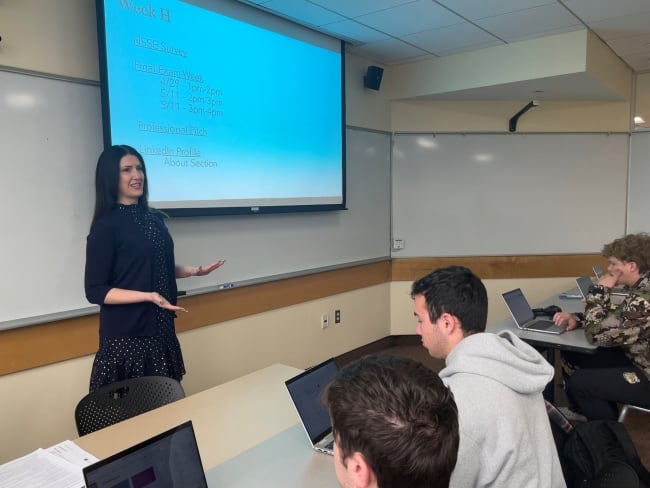You have /5 articles left.
Sign up for a free account or log in.

Faculty and staff, including Veronica Stewart, director of the Amica Center for Career Education, at Bryant University teach a career-preparation course to first-year students as part of the general education requirements.
Bryant University
A winter 2023 Student Voice survey by Inside Higher Ed and College Pulse found 31 percent of students had never interacted with their college or university’s career center, with first-year college students the least likely to have interacted with the career center (39 percent).
To better equip students for their lives after graduation, as well as reduce equity gaps in career preparation and exploration activities, Bryant University redesigned its general education requirements to include a one-credit course on career development.
The course, launched this spring, teaches students core competencies, gives them career self-management skills and empowers them to advocate for themselves in professional settings.
The background: As part of Vision 2030, Bryant’s most recent strategic plan, administrators reconsidered the goals of the existing general education courses and established a three-part course series for the first year. Each of the new general education courses also align with the United Nation’s Sustainability Goals.
In the fall, incoming students take GEN 100—Student Success at Bryant, which covers transitioning to college, adaptability, accountability and resiliency, as well as diversity, equity and inclusion at the university and how to cultivate habits for lifelong success.
Prior to the spring term, students participate in IDEA, short for Innovation and Design Experience for All, a three-day crash course on innovation and design-thinking.
First-Year Seminars and Career Prep
Increasingly, colleges and universities are embedding career exploration and other mapping exercises into first-year experience courses. These elements are designed to steer students early in their academic journeys and help address concerns about the return on investment of higher education.
Read more on strategies to get first-year students engaged in career services here.
Then in the spring, students enroll in GEN 103—Career Launch, which guides learners through their interests and values and helps prepare them for landing their dream job after graduation.
What’s the need: The Student Voice survey found 16 percent of first-year college students say an important outcome of their college experience is they want to have a clear idea of which career they want to pursue, the largest share among each class.
The course not only supports undeclared students in identifying a major, but also instills confidence in students with a major to work toward their dream job, explains Veronica Stewart, Bryant’s director of the Amica Center for Career Education and GEN 103 coordinator.
“It kind of forces students to reflect on the why behind all of these topics,” Stewart says. “It’s not just, ‘Let’s look at this list of majors and select one that you think is a good fit based on your general academic interests,’ but it’s ‘why could a number of good majors be a good fit for you, but why is this one going to fit into the bigger picture of your career development story?’”
The 15-week course encourages regular reflection and engagement on career topics early, which the university scaffolds throughout the rest of their college experience.
How it works: Some of the barriers to students’ engagement with the career center are a lack of knowledge around services offered and limited time to commit to career exploration. GEN 103 eliminates those barriers by providing curated curriculum to learners and by requiring participation among all new students.
Bryant currently has over 900 first-year students enrolled across 32 sections of GEN 103 taught (and co-taught) by 35 instructors who are both faculty and staff members.
Throughout the course, students take a career self-assessment, practice career exploration and complete professional-development activities.
“The major goal is that students have career self-management skills,” Stewart says. “We want them to be confident that if a career center never existed, they’d know how to make informed decisions for themselves and go advocate for themselves in the application process in the workplace.”
Students also learn how to articulate the eight National Association of Colleges and Employers (NACE) career competencies, conduct an interview with a career professional, research job and internship positions, and network. Bryant instructors highlight the differences between self-advocacy and marketing oneself, as well.
“Marketing yourself could be sending a résumé to 50 different internship applications, but advocating for yourself would be spending time on a few organizations and following up after sending that résumé to really connect with people,” Stewart says. “Marketing yourself could be learning a professional elevator pitch that’s a list of your skills and education. But advocating for oneself would mean students are taking the time to express why they’re genuinely interested in the goals or the mission of the organization.”
What’s next: Throughout the semester, Stewart is collecting feedback and artifacts from students, faculty and staff to evaluate the curriculum and how it’s benefiting learners.
“Students are letting us know that they’re excited, they’re surprised by the information, they’re motivated to learn more and to explore experiential education in their fields of interest sooner than they may have before they’ve taken the course,” Stewart says.
The course will also undergo formal assessment as part of the gen ed redesign to ensure its learning outcomes of professional skills and career self-management.
Do you have a career prep tip that might help others encourage student success? Tell us about it.




